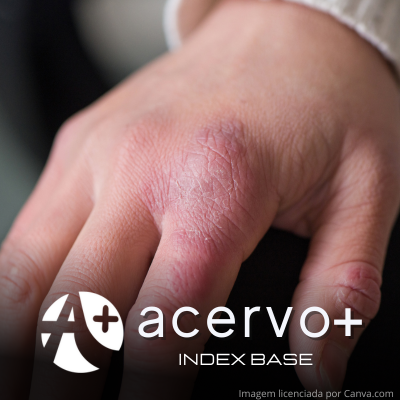Dermatomiosite juvenil
##plugins.themes.bootstrap3.article.main##
Resumo
Objetivo: Analisar as características da dermatomiosite juvenil (DMJ). Revisão bibliográfica: A DMJ é bastante rara, mas é a miopatia inflamatória idiopática mais comum em pacientes pediátricos. A doença é caracterizada por fraqueza muscular proximal, erupções cutâneas características e vasculopatia. A incidência de dermatomiosite juvenil é estimada em cerca de 2 a 4 por um milhão de crianças, com diferenças entre grupos raciais e étnicos. Sua etiologia é desconhecida, mas sugere-se a DMJ é causada por uma reação autoimune em indivíduos geneticamente susceptíveis, possivelmente em resposta a infecção ou outros agentes ambientais. Os anticorpos específicos de miosite (MSAs) podem ser úteis na identificação do fenótipo da doença. Considerações finais: Apesar de sua raridade a DMJ é uma doença autoimune que tem grande impacto na qualidade de vida, podendo ter complicações potencialmente letais como pulmonares e cardiovasculares. Nesse sentido, torna-se essencial seu diagnóstico precoce e tratamento adequado. Sua terapêutica é feita com os medicamentos de primeira linha (glicocorticóides e metotrexato) e com os remédios de segunda linha (rituximabe, micofenolato mofetil e ciclofosfamida) visando a doença clinicamente inativa. Além disso, os inibidores da Janus quinase são promissores no tratamento das formas refratárias.
##plugins.themes.bootstrap3.article.details##
Copyright © | Todos os direitos reservados.
A revista detém os direitos autorais exclusivos de publicação deste artigo nos termos da lei 9610/98.
Reprodução parcial
É livre o uso de partes do texto, figuras e questionário do artigo, sendo obrigatória a citação dos autores e revista.
Reprodução total
É expressamente proibida, devendo ser autorizada pela revista.
Referências
2. BOROS C, et al. Juvenile Dermatomyositis: what comes next? Long-term outcomes in childhood myositis from a patient perspective. Pediatr Rheumatol Online J, 2022; 20(1): 102.
3. CAMPANILHO-MARQUES R, et al. Retrospective analysis of infliximab and adalimumab treatment in a large cohort of juvenile dermatomyositis patients. Arthritis Res Ther, 2020; 22(1): 79.
4. EL-GARF K, et al. juvenile dermatomyositis: demographics, characteristics and disease outcome in an Egyptian cohort. Clin Exp Rheumatol, 2022; 40(2): 450-456.
5. ENDERS FB, et al. Consensus-based recommendations for the management of juvenile dermatomyositis. Ann Rheum Dis, 2017; 76(2): 329-340.
6. GARGH K, et al. Juvenile Dermatomyositis Magnetic Resonance Imaging Score (JIS) does not correlate with criteria for clinically inactive disease: a single-centre retrospective evaluation. Rheumatol Int, 2022; 42(7): 1221-1226.
7. KIM H, et al. Updates on Juvenile Dermatomyositis from the Last Decade: Classification to Outcomes. Rheum Dis Clin North Am, 2021; 47(4): 669-690.
8. KWIATKOWSKA D e REICH A. The Significance of Autoantibodies in Juvenile Dermatomyositis. Biomed Res Int, 2021; 2021: 5513544.
9. LEBRON CV, et al. Treatment With Rituximab in Juvenile Dermatomyositis: Effect on Calcinosis. Reumatol Clin (Engl Ed), 2020; 16(5): 368-370.
10. LERKVALEEKUL B, et al. Siglec-1 expression on monocytes is associated with the interferon signature in juvenile dermatomyositis and can predict treatment response. Rheumatology (Oxford), 2022; 61(5): 2144-2155.
11. LE VOYER T, et al. JAK inhibitors are effective in a subset of patients with juvenile dermatomyositis: a monocentric retrospective study. Rheumatology (Oxford), 2021; 60(12): 5801-5808.
12. LI D e TANSLEY SL. Juvenile Dermatomyositis-Clinical Phenotypes. Curr Rheumatol Rep, 2019; 21(12): 74.
13. MCCANN LJ, et al. Juvenile dermatomyositis. Where are we now? Clin Exp Rheumatol, 2022; 40(2): 394-403.
14. MONDAL S, et al. Cardiovascular Abnormalities in Juvenile Dermatomyositis: A Scoping Review for the Clinical Rheumatologists. Front Med (Lausanne), 2022; 9: 827539.
15. NITIYAROM R, et al. Juvenile dermatomyositis in Thai children: Retrospective review of 30 cases from a tertiary care center. Indian J Dermatol Venereol Leprol, 2022; 88(2): 162-170.
16. PAPADOPOULOU C e WEDDERBURN LR. Treatment of Juvenile Dermatomyositis: An Update. Paediatr Drugs, 2017; 19(5): 423-434.
17. PACHMAN LM e KHOJAH AM. Advances in Juvenile Dermatomyositis: Myositis Specific Antibodies Aid in Understanding Disease Heterogeneity. J Pediatr, 2018; 195: 16-27.
18. PINOTTI CS, et al. Calcinosis in juvenile dermatomyositis: Updates on pathogenesis and treatment. Front Med (Lausanne), 2023; 10: 1155839.
19. STINGL C, et al. ene Expression Profiles of Treatment Response and Non-Response in Children With Juvenile Dermatomyositis. ACR Open Rheumatol, 2022; 4(8): 671-681.
20. TANBOON J, et al. Dermatomyositis: Muscle Pathology According to Antibody Subtypes. Neurology, 2022; 98(7): 739-749.

